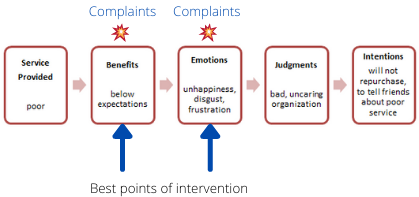
No organization wants to lose customers. Hence organizations always strive to prevent customer disloyalty. However, to succeed in doing so, it’s essential to first understand how customers become disloyal.
It all starts with the service provided. Service, from the customer’s perspective, is a combination of the customer’s experience and their perception of the outcome of the service.
For example, if a patient is ill and visits a hospital, the customer experience includes the interaction with the receptionist, the courtesy of the nurses and doctors, the waiting time, and the ambience of the hospital environment. The service outcome is the result of the medical treatment received – the state of the patient’s health after the visit to the hospital.
These two elements, customer experience and the service outcome, form what the customer sees as service. And whenever the customer receives service, it triggers a set of outcomes which include benefits, emotions, judgments and intentions. See Figure 1.

Figure 1
Benefit is the customer’s assessment of the service weighed against the ‘expected.’ Benefits at a restaurant, for example, will include the experience (the treatment by the waiter) and tangible outcomes (such as the quality and quantity of food) weighed against the customer’s expectations.
Emotions are strong mental or instinctive feelings, such as pleasure or frustration, delight or disgust. These may be concerned with the tangible benefits and/or the way the customer was treated (the experience). For example, a customer may feel annoyed and upset that the quality of food at a restaurant was poor or even if the food were of great quality the customer may feel displeasure about the way they were treated by the waiter.
Judgments are opinions that form as a result of the customer’s feelings about their experience and the outcomes. These judgments will include views about fairness, satisfaction and, importantly, perceived value.
Then these judgments, good, bad or indifferent, will result in intentions, such as the intention to repurchase or not, or the intention to tell friends and relatives how good or bad the service was.
So when an organization provides service, the benefits the customer perceives will give rise to some emotions. These emotions will lead to judgments. And after judgments come intentions. Expectedly, when these outcomes are negative, the customer becomes disloyal. See Figure 2.

Figure 2
When the service provided is poor, the benefits the customer receives are below their expectations resulting in unhappiness, disgust, or frustration. These feelings shape their opinion about the organization with the resultant judgment that the organization is bad and uncaring. This judgment will lead to disloyalty – intention to not repurchase.
But here’s the point: Organizations can intervene and recover customers at some point in their journey to disloyalty. This intervention is most effective if done at the Benefits and Emotions stages because these are stages at which customers typically complain.
The other outcomes – Judgments and Intentions – are latent. Customers don’t express them easily so they go unnoticed, giving organizations little or no chance to intervene and possibly recover the customer.

Figure 3
Thus, to nip customers’ journey to disloyalty in the bud, organizations must intervene at the Benefits and Emotions stages (Figure 3). Otherwise, it becomes more difficult down the line particularly after opinions have been formed at the Judgments stage.
But knowing when to intervene is not enough. Equally or even more important is knowing how to – having the skills to handle the complaints effectively. This is critical. And many organizations fail here, letting customers slip into disloyalty.
So how are complaints currently being handled in your organization? … well enough to prevent customer disloyalty?